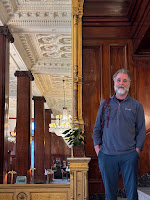It’s a writing day and of course I ate something, possibly too much of something, last night and this morning my digestion is out of sorts. I’m going to blame the Brussels sprouts—apparently gas and bloating caused by fiber and sulfur in them is a thing on the internet. I will have to limit my sprouts intake and be extra certain to chew them thoroughly. In the old days, I only encountered them on Thanksgiving, and could avoid eating them with a well-placed table napkin. Okay—that only worked once, and has become an annual family story.
Lately, The Child has been dropping by the house somewhat unannounced to borrow the car. Aside from the typical parental concerns around young sons’ driving habits, borrowing the car is fine. However, it did prompt Mark last Thursday night to make a sign out of red construction paper that read “Private Event (wink wink nudge nudge)” and hang it on the door nob of our front door to prevent The Child from randomly crossing the threshold and being Deeply Psychologically Scarred by the Unsettling Sight (and Sound) of His Fathers Engaging in Cis-Gay-Male Gnosis.
Being raised Corvallis-Nice, and having never had a Noah in the Tent moment with my parents, I appreciate Mark’s directness in preventing a retelling of Lot’s Fathers. I suspect The Child appreciated The Sign when Mark showed it to him Friday, but it was a little hard to tell by his deadpan poker face.
It was easier to partition The Child from our Moments of Epiphany when he was younger, naps were more regular, and sleep was thickly swathed in oblivion. Our nearest Moment of Revelation was decades ago, when The Child woke and rushed into our room with the report of a dream of roaring lions. I’m glad for our record, and sometimes miss the old certainty that our curated Moments Beyond The Veil would stay Beyond The Veil.





















